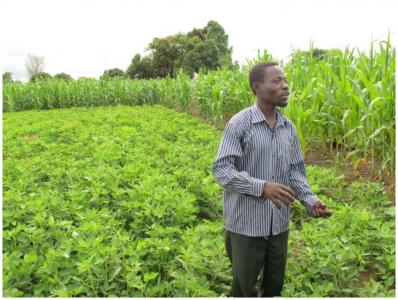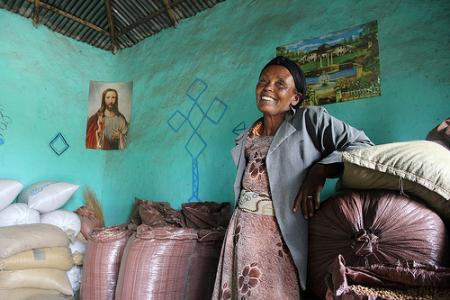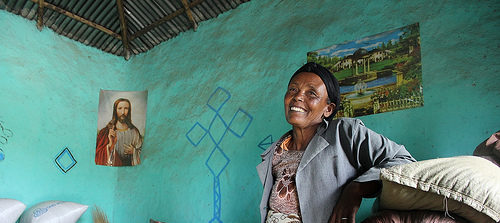Why Sustainable Agricultural Practices?
The past few decades have witnessed low and declining performance of the agricultural sector in Sub Saharan Africa (SSA) mainly due to continued land degradation, decline of soil fertility, and widespread failure to make sufficient soil fertility replenishment. The concern about poor performance of the agricultural sector and agriculture’s increasing reliance on non-renewable resources has promoted a number of sustainable agriculture initiatives to support the adoption and diffusion of sustainable agricultural practices (SAPs).
Sustainable agriculture refers to the capacity of agriculture to contribute to the overall welfare by providing sufficient food and other goods and services in a way that are economically efficient and profitable, socially responsible and environmentally sound. Accordingly these practices may include conservation tillage, legume intercropping, legume crop rotations, improved crop varieties, use of animal manure, complementary use of inorganic fertilizers, and soil and stone bunds for soil and water conservation.
Why adoption of multiple SAPs?
Despite the considerable efforts of governmental and non-governmental bodies for promoting the adoption and diffusion of SAPs, the uptake of SAPs by farmers are still poor in developing countries. A better understanding of constraints that condition farmer’ adoption behaviors are therefore important for designing policies that could stimulate adoption of SAPs. In the past, many studies have been performed on the adoption of new technologies. However, relatively little work has been done to examine the socio-economic factors affecting multiple adoption of SAPs. Hence, studies on adoption of SAPs jointly could clarify the reality faced by farmers who are often faced with various technologies that may be adopted simultaneously as compliments, substitutes or supplements to deal with their overlapping constraints. Hence, in order to find empirical evidence on key factors affecting multiple adoptions of SAPS, household surveys were conducted recently in Ethiopia with the support by the Australian Center for International Agricultural Research (ACIAR) under the CIMMYT-led project “Sustainable Intensification of Maize-Legume Systems for Food Security in Eastern and Southern Africa (SIMLESA).
 (Photo of Ethiopian farmer, courtesy of SIMLESA)
(Photo of Ethiopian farmer, courtesy of SIMLESA)
Interdependence among SAPs
Identifying the nature of interrelationships (complementarity or substitutability) of the set of practices helps policy makers and development practitioners to define their strategies in a piecemeal or in a package for promoting agricultural technologies. We studied five different SAPs: maize-legume rotation, conservation tillage, modern seeds, application of manure and inorganic fertilizers. The result provides empirical evidence to support the notion of interdependence between adoption decisions of the different practices. For instance, manure significantly substitutes with commercial fertilizer, crop rotation and conservation tillage. On the other hand, improved crop variety is complementary with crop rotation, commercial fertilizer and manure. This means adopting a given practice is depending on whether another complementary practice has been adopted or not. This cross-technology correlation information may have important policy implications in that a policy change that can affect one SAP can have spillover effects on the adoption of other SAPs.
Factors influencing adoption of SAPs and policy implications
Better output market access influences the likelihood of adoption of seed variety and conservation tillage by facilitating product transport, reducing the cost of the farmers’ time and enabling them to obtain timely market information. This suggests improving the road infrastructure and access to a public transportation system is important in facilitating adoption.
Household wealth positively influences the adoption of modern crop variety, commercial fertilizer and conservation tillage, reflecting the capacity to purchase external inputs and to cope with greater risk. Conservation tillage usually involves use of herbicides and/or additional labour to control for weeding. In the presence of limited family labour, conservation tillage can be more affordable to wealthier households who can hire labor or purchase chemical to control weeds. Credit constraints negatively affect the adoption of modern crop varieties and commercial fertilizers, implying that that liquidity constrained households are less likely to adopt SAPs that require cash outlays. These result calls for improving the country’s credit delivery system.
The probability of adoption of inorganic fertilizer and crop-rotation is high in areas/years where rainfall is reliable in terms of timing, amount, and distribution. This is consistent with other previous studies who found that inorganic fertilizers provide a higher crop return per hectare in wetter areas than in drier areas. The results suggest the need for better rainfall forecasts not only amount but also timing and distribution; careful agro-ecological targeting in the development, promotion, and scaling up of SAPs.
 (Photo of Temegnush Dhabi owns a two-hectare farm in central Ethiopia, courtesy of The Gates Foundation via flickr)
(Photo of Temegnush Dhabi owns a two-hectare farm in central Ethiopia, courtesy of The Gates Foundation via flickr)
Social capital (household’s membership of a rural institution, a kinship network and trust in traders) affects positively the probability of SAPs adoption. With scarce or inadequate information sources and imperfect markets, social networks such as traders’ and farmers’ associations or groups facilitate the exchange of information, and enable farmers to access inputs on schedule and overcome credit constraints. The significant role of social capital on adoption suggests the need for establishing and strengthening local institutions and service providers to accelerate and sustain technology adoption.
Households that trust that the government will provide support when crops fail are more likely to adopt seed variety and inorganic fertilizer, probably because the benefit of these technologies is uncertain and farmers want insurance in order to adopt them. On the other hand, those with less trust in government support are more likely to adopt practices that depend on local resources such as manure. For the policy makers, this suggests that investment in public safety net programs (public insurance) and risk-protection mechanisms can be expected to have a positive impact on the adoption of SAPs.
Farmers that have confidence in the skills of extension agents are more likely to adopt the conservation tillage practice, since this practice is relatively knowledge-intensive and requires considerable management input. However, the frequency of extension contact has no impact on adoption of this practice. This may indicate that it is not the simple contact per se that affects adoption, but rather the quality of the extension services. The policy implication of this is the importance of building the capacity of extension agents to avoid inefficiency and ineffectiveness that increases distrust and transaction costs.
Given the fact that the benefits from long-term investments (e.g., manure and conservation tillage) accrue over time, this inter-temporal aspect suggests that secure land access or tenure will impact adoption decisions positively. Women’s education in the household has a significant and positive effect on the probability and level of SAP use, suggesting investment in rural public education with special focus on women will facilitate the adoption of technologies and practices.
Biography
Hailemariam Teklewold has completed his doctorate in environmental economics at the University of Gothenburg, Sweden. He has been working as an agricultural economist in socio-economics unit at the Ethiopian Institute of Agricultural Research. He is also a researcher for Environment for Development ( EfD) Ethiopia.
Essays on the Economics of Sustainable Agricultural Technologies in Ethiopia
